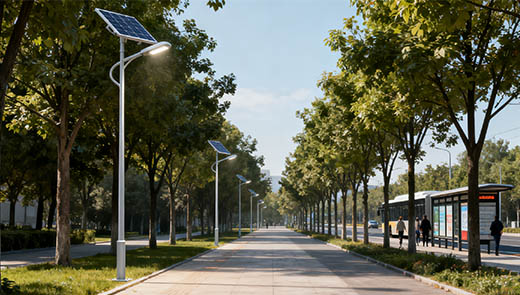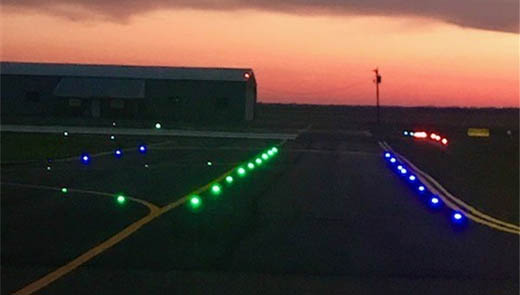How Do You Maintain a Solar Street Light?
As a common energy-efficient outdoor lighting fixture, solar street lights are constantly exposed to natural elements like dust, wind, rain, and temperature fluctuations. Ensuring their stable operation and optimal illumination requires scientific and standardized maintenance. Understanding maintenance classifications, key points, and efficiency-boosting techniques is fundamental to securing their long-term value.
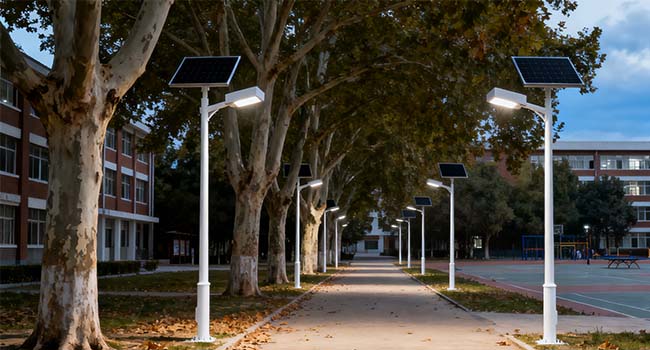
Importance of Regular Maintenance
As outdoor lighting devices reliant on natural energy, solar street lights require periodic maintenance for sustained, reliable operation. Neglecting upkeep not only directly compromises illumination but also shortens overall equipment lifespan, increasing future replacement costs.
The core value of regular maintenance manifests in three key areas: First, it ensures full-capacity operation by promptly addressing component wear, guaranteeing coordinated functioning of solar panels, batteries, and luminaires to prevent system failure from single-point failures. Second, it extends equipment lifespan. Through cleaning, inspection, and repairs, component aging is slowed. Most solar street lights undergo standardized maintenance can have their service life extended by 3-5 years. Third, it maintains energy efficiency. Clean solar panels can increase light absorption efficiency by over 30%, while healthy batteries reduce power loss, sustaining the “zero electricity cost” lighting advantage. The difference between long-term neglect and regular maintenance is stark, as illustrated in the table below:
|
Maintenance Condition |
Solar Panel Efficiency |
Battery Lifespan |
Lighting Performance |
Safety Risk |
|
Regular Maintenance |
Maintains above 85% |
5–8 years |
Stable brightness, even coverage |
Low — minimal risk of leakage or pole tilting |
|
Long-Term Neglect |
Drops below 50% |
2–3 years |
Dimming, frequent outages |
High — risk of battery leakage and pole corrosion or tilting |
What are the Maintenance Categories for Solar Street Lights?
Solar Panels
Clean solar street lights every 1-2 months depending on the environment. In areas with heavy dust or low rainfall, clean every 2 weeks. Use a soft cloth or sponge dipped in clean water for wiping. For stubborn stains, add a small amount of neutral detergent. Avoid using hard objects to scrape the surface to prevent damaging the panel coating. After cleaning, inspect the panel condition for cracks (damaged panels may allow water ingress causing short circuits; replace immediately if found). Also check for loose wiring connections; tighten any loose connections and ensure proper waterproofing.
Battery
Open the battery compartment monthly for inspection. Focus on checking the battery's appearance for leakage, swelling, or damaged casing. Verify that the positive and negative terminals are secure and free of oxidation. Ensure the battery compartment remains dry (humid environments can cause component corrosion). If oxidation is found on terminals, gently sand it off with sandpaper. Apply petroleum jelly for protection against re-oxidation. Finally, re-tighten the wiring to prevent reduced charging efficiency due to poor contact.
Test battery capacity every 3 months by checking the voltage via the controller. If the voltage consistently falls below 10V, it indicates the battery capacity has degraded by over 50% and requires replacement. Standard lead-acid batteries have a lifespan of approximately 5 years, while lithium batteries last about 8 years. Replace the entire battery set when it reaches the end of its service life. Do not mix new and old batteries (significant capacity differences between new and old batteries can cause excessive discharge of new batteries, shortening their lifespan).
Lighting Fixtures
Monthly nighttime inspections should assess solar street light illumination. If noticeable dimming, flickering, or failure occurs, first disconnect power. Check if bulbs appear blackened or filaments are broken. Simultaneously inspect the driver for burning odors or overheated casings. Every 3 months, verify fixture angles. Strong winds or impacts may tilt fixtures, affecting coverage. Every 2 months, wipe the fixture housing with a damp cloth. Dust and insect remains can accumulate on the housing, obstructing light transmission. If the housing has a transparent cover, take care to avoid scratches during cleaning to maintain its light transmission efficiency. Every six months, inspect the luminaire's waterproof seal (waterproofing directly affects internal circuit safety). Check for aging or cracked sealing gaskets and signs of water ingress at the junction between the lampshade and body. Replace aged gaskets promptly. If water ingress is detected, thoroughly dry the interior and reseal to prevent short circuits and luminaire burnout.
Light Pole and Mounting Structure
Inspect the stability of street light poles every 3 months. Check for tilting or wobbling of the pole and for settlement or cracking of the foundation base. If the pole tilt exceeds 3°, adjust it promptly. If the foundation cracks, fill with concrete to repair and prevent further settlement. Inspect the pole's corrosion resistance annually. Most poles are made of steel and are prone to rust when exposed to the outdoors for extended periods. Check the surface paint for peeling. If rust spots or paint flaking are found, first sand the area to remove rust, then apply rust-proof paint and exterior paint to extend the pole's service life.
If surrounding conditions change (e.g., road widening, tree growth), adjust the solar street light pole height as needed. Ensure the pole remains vertical during adjustment, and the new height complies with lighting design standards (typically 6-12 meters for main roads, 3-6 meters for residential areas).
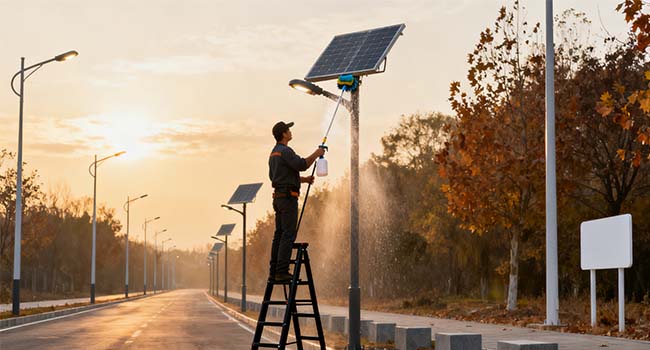
Performance Enhancement Techniques Beyond Solar Street Light Maintenance
Regular Monitoring
It is recommended to regularly monitor key data via the controller, including daily solar panel power generation, battery charge/discharge curves, and lamp operating duration. If abnormal data is detected (e.g., sudden drop in power generation, excessively fast discharge rate), promptly inspect corresponding components. Check whether solar panels are obstructed or batteries are aging to ensure issues are resolved early, preventing sustained performance decline of the solar street lights.
Timer and Sensor Adjustments
Flexibly adjust lighting strategies based on seasons and usage scenarios to reduce unnecessary energy consumption:
Seasonal perspective: During summer with longer daylight hours, set lighting hours to “19:00 - 5:00 the next day.”Winter with shorter daylight hours, adjust to “17:30 - 6:30 the next day” to avoid daytime lighting waste. From a sensor optimization perspective, if motion sensors are installed, adjust sensitivity based on foot traffic. For example, keep main roads in constant-on mode while setting residential walkways to “light up when people approach, dim when they leave” to further reduce energy consumption.
Equipment Upgrades and Retrofits
For solar street lights in use for over five years, performance enhancements can be achieved through technological upgrades. Common approaches include three key areas: First, solar panel upgrades—replacing standard monocrystalline silicon panels with high-efficiency heterojunction (HJT) panels, boosting power generation efficiency by 15%-20% to enhance energy collection capacity. Second, battery upgrades: Replace lead-acid batteries with lithium batteries, which are lighter, have longer lifespans, and offer more stable low-temperature performance (ideal for cold northern regions). Third, controller upgrades: Switch to smart controllers enabling remote monitoring and automatic adjustment of charging parameters, reducing manual maintenance costs and improving management efficiency.
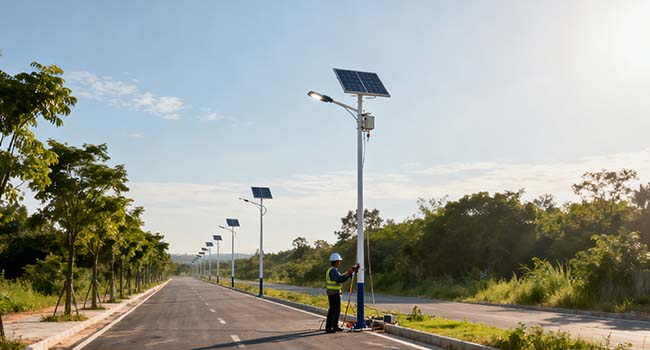
What are some Practical Maintenance Tips for Solar Street Lights?
Establish a Maintenance Schedule
Develop monthly, quarterly, and annual maintenance schedules based on local climate conditions (e.g., high rainfall, dusty environments, extreme cold) and equipment lifespan. Specify the timing (e.g., monthly battery checks, quarterly pole stability inspections), maintenance tasks (e.g., cleaning, testing, tightening), and responsible personnel for each category. This prevents premature component failure due to missed maintenance and ensures orderly implementation of upkeep.
Prepare Dedicated Maintenance Tools
Stock up on specialized tools for solar street light maintenance in advance. This includes soft cloths, neutral detergent (for cleaning solar panels and fixture housings), sandpaper (for rust removal and terminal oxidation treatment), wrenches (for tightening screws), multimeters (for testing battery voltage), and insulated gloves (for electrical shock prevention). A complete set of tools enhances operational efficiency, prevents maintenance interruptions or non-compliant operations due to missing tools, and ensures maintenance tasks are completed successfully.
Implement Safety Precautions
When performing elevated work (e.g., inspecting pole tops or adjusting solar panel angles), use certified ladders or climbing equipment. Climbing poles directly is strictly prohibited to prevent falls. Before inspecting live components like batteries or controllers, disconnect power sources to avoid electric shock or short circuits. Wear insulated gloves during operations to further mitigate risks and ensure personnel safety.
It is evident that solar street light maintenance must encompass all components—solar panels, batteries, luminaires, and poles—and integrate regular monitoring, intelligent adjustments, and equipment upgrades. This must be executed through well-planned schedules and rigorous safety protocols. Only by thoroughly implementing these maintenance procedures can operational risks be effectively mitigated, ensuring solar street lights deliver continuous, reliable illumination services while maximizing their environmental and economic value.


